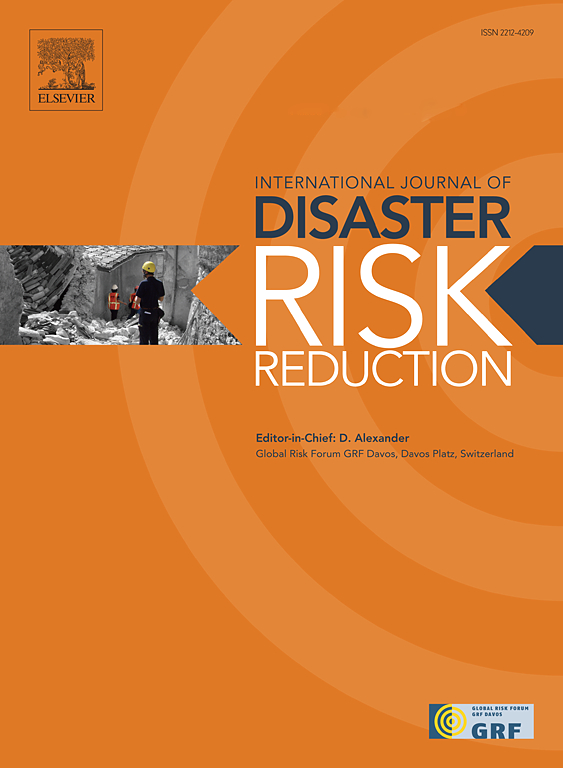City-scale high-resolution flood nowcasting based on high-performance hydrodynamic modelling
IF 4.2
1区 地球科学
Q1 GEOSCIENCES, MULTIDISCIPLINARY
International journal of disaster risk reduction
Pub Date : 2025-05-16
DOI:10.1016/j.ijdrr.2025.105584
引用次数: 0
Abstract
Effective flood early warning systems serve as a cornerstone in mitigating the impacts of urban flood disasters. Nevertheless, contemporary urban flood warning systems encounter significant technical challenges, particularly the high uncertainty and low spatiotemporal resolution associated with rainfall forecasting and the inefficiency in flood modelling, especially for large-scale and high-resolution predictions. This study introduces an urban flood nowcasting system designed to tackle key technical challenges in flood prediction. The proposed framework employs a multi Graphics Processing Unit (GPU) accelerated shallow water equation (SWE) model, enabling high-resolution predictions of inundation distributions across urban surfaces within a limited time frame. To validate its effectiveness, the framework was applied to a vast urban area spanning 779 km2 in Guangdong Province, China. Through the simulation of a representative extreme flood event, the accuracy and computational efficiency of the flood nowcasting system were comprehensively demonstrated, showcasing its potential for real-world applications in urban flood early warning and disaster management. Furthermore, a comprehensive evaluation of the impact of rainfall spatial and temporal resolutions on flood modelling was conducted. The results reveal that the proposed model can predict a 4 h flood event with a spatial resolution of 4 m in just 10 min, harnessing the parallel computing capabilities of 16 GPUs. This established flood nowcasting framework offers strong technical support for the accurate prediction and early warning of urban flood disasters, enhancing disaster preparedness and response.
基于高性能水动力建模的城市尺度高分辨率洪水临近预报
有效的洪水预警系统是减轻城市洪涝灾害影响的基石。然而,当代城市洪水预警系统面临着重大的技术挑战,特别是与降雨预报相关的高不确定性和低时空分辨率,以及洪水模型的低效率,特别是大规模和高分辨率预测。本文介绍了一种城市洪水临近预报系统,旨在解决洪水预报中的关键技术难题。该框架采用多图形处理单元(GPU)加速浅水方程(SWE)模型,能够在有限的时间框架内对城市表面的淹没分布进行高分辨率预测。为了验证其有效性,将该框架应用于中国广东省779平方公里的广阔城市区域。通过对一个典型极端洪水事件的模拟,全面展示了洪水临近预报系统的准确性和计算效率,展示了其在城市洪水预警和灾害管理中的实际应用潜力。此外,还对降雨时空分辨率对洪水模拟的影响进行了综合评价。结果表明,该模型可以利用16个gpu的并行计算能力,在10分钟内以4 m的空间分辨率预测一个4 h的洪水事件。建立的洪水临近预报框架,为城市洪涝灾害的准确预报预警,提高备灾响应能力提供了强有力的技术支撑。
本文章由计算机程序翻译,如有差异,请以英文原文为准。
求助全文
约1分钟内获得全文
求助全文
来源期刊

International journal of disaster risk reduction
GEOSCIENCES, MULTIDISCIPLINARYMETEOROLOGY-METEOROLOGY & ATMOSPHERIC SCIENCES
CiteScore
8.70
自引率
18.00%
发文量
688
审稿时长
79 days
期刊介绍:
The International Journal of Disaster Risk Reduction (IJDRR) is the journal for researchers, policymakers and practitioners across diverse disciplines: earth sciences and their implications; environmental sciences; engineering; urban studies; geography; and the social sciences. IJDRR publishes fundamental and applied research, critical reviews, policy papers and case studies with a particular focus on multi-disciplinary research that aims to reduce the impact of natural, technological, social and intentional disasters. IJDRR stimulates exchange of ideas and knowledge transfer on disaster research, mitigation, adaptation, prevention and risk reduction at all geographical scales: local, national and international.
Key topics:-
-multifaceted disaster and cascading disasters
-the development of disaster risk reduction strategies and techniques
-discussion and development of effective warning and educational systems for risk management at all levels
-disasters associated with climate change
-vulnerability analysis and vulnerability trends
-emerging risks
-resilience against disasters.
The journal particularly encourages papers that approach risk from a multi-disciplinary perspective.
 求助内容:
求助内容: 应助结果提醒方式:
应助结果提醒方式:


